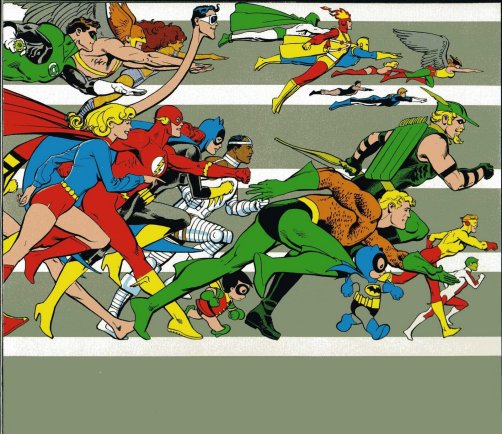
Greetings internet travelers, and welcome to a particularly fascinating edition of Into the Bronze Age! I’ve got something special for y’all today, something that surprised the dickens out of me! I’ve got a story that was much less enjoyable than I expected and a story that was vastly more enjoyable as well. I’m sure y’all will be as surprised as I was. So, let’s get right into this post’s features!
If you’re new to this little journey, you can check out the first post to learn what it’s all about.
- Action Comics #394
- Adventure Comics #399
- Batman #226 (the debut of the awe-inspiring Ten-Eyed Man!)
- Brave and Bold #92
- Detective Comics #405
- The Flash #201
- G.I. Combat #144
- Justice League of America #84
- Superman’s Girlfriend, Lois Lane #106
- Superman #231
- World’s Finest #197 (reprints, won’t be covered)
- World’s Finest #198
Bolded entries are covered in this post, the others will be covered soon.
G.I. Combat #144
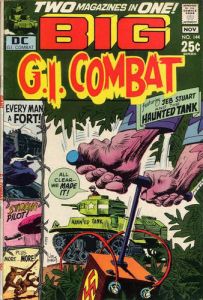 “Every Man a Fort”
“Every Man a Fort”
Writer: Robert Kanigher
Penciler: Russ Heath
Inker: Russ Heath
Cover Artist: Joe Kubert
This is an unusual and fun issue of the Haunted Tank. Unfortunately, the ghost of the titular haunting still doesn’t really contribute anything, but the book sticks out because the story it tells actually touches on the origin of the heroic tank crew who star in these tales. This issue gives us the first meeting of the tank crew in tank training, and a memorable meeting it is. We also get the first meeting of Jeb and J.E.B., which is much less interesting and something of a let-down. For the third book in a row, Robert Kanigher turns in a perfectly serviceable story without any glaring flaws. Maybe we were just in a lull for him. I suppose time will tell which set of stories was the fluke, the terrible or the tolerable.

This particular tale begins in media res, with the Haunted Tank taking on a German panther, smashing the other steel beast, but being rocked by their fire in return. Jeb is blown out of the hatch and has his bell rung but good. He begins murmuring about the crew’s first meeting, which leads us to a flashback and reveals something I didn’t know. Jeb is a Yankee! This also comes as a surprise to the other three members of the crew, Slim, Rick, and Arch, who are all Southerners. They don’t display good Southern manners, however, instead telling Jeb that, since he’s a Northerner, he’s not fit to bear the name of the famous Confederate general. What follows is an episode out of the Three Musketeers, as Jeb, with quiet courage, puts up a list, saying that anyone who wants to try to make him change his name is welcome to sign it. Shortly, he’s got three different appointments for fights, which Russ Heath illustrates wonderfully. Shades of d’Artagnan!
First Slim cleans his clock, but as soon as he has recovered, Jeb seeks out the next name on the list, introducing himself as Jeb Stuart. So, next up, Rick rearranges his face. Still undeterred, Jeb approaches Arch, and after a brutal fight, the three tankers accept him, telling their former foe that he’s earned the right to that name, in spades! It’s a great sequence, and it establishes Jeb’s character in an endearing, hard-won fashion. I do wish we had gotten a bit more development of the other three crew members, as they remain little more than names.

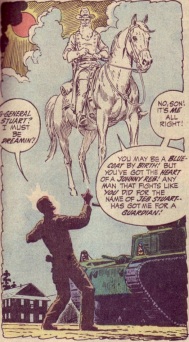 Later that night, Jeb is visited by his namesake, who tells him that he has the heart of a “Johnny Reb,” and that the ghost will be proud to be his guardian. It’s a bit lackluster, to be honest. I like that he recognizes the tank commander’s fighting spirit, but I would have preferred that their first meeting be a tad more dramatic.
Later that night, Jeb is visited by his namesake, who tells him that he has the heart of a “Johnny Reb,” and that the ghost will be proud to be his guardian. It’s a bit lackluster, to be honest. I like that he recognizes the tank commander’s fighting spirit, but I would have preferred that their first meeting be a tad more dramatic.
Nonetheless, the flashback rolls on, and we join the Haunted Tank on its first mission, to reinforce a fort overlooking vital supply routes in North Africa. We get a really nice scene where the crew stops to pray, only to be ambushed by a half-track. I quite enjoy little moments of faith like that. They manage to dispatch that threat, only to arrive at the fort too late. It has already been bombed to smithereens by the Luftwaffe. That brings us back to the present, and the crew carries on with Jeb still delirious.
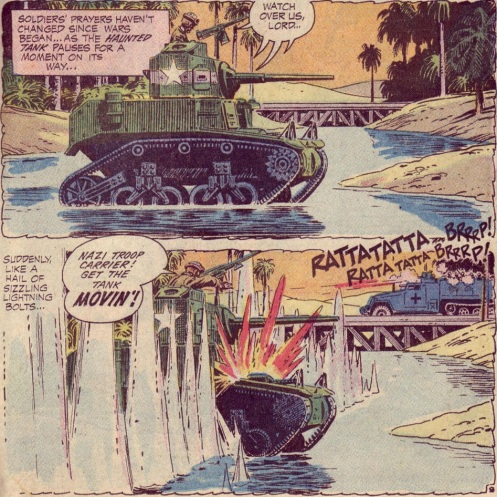
They spot a train carrying supplies for Rommel, and they realize it is up to their tank to stop it. Yet, try as they might in a vicious running firefight, once again, nicely drawn by Heath, they can’t smash through its armor. Now, that seems a bit silly, but they actually did have armored trains, so it’s not quite as goofy as it seems, especially given the small gun on a Stuart. Anyway, Jeb comes to just in time, ordering Slim to ram the engine, a desperate gamble that pays off, sending the train and all of its ammo and fuel over a cliff and saving the day. As usual, the General appears once the action is over to offer unhelpful commentary rather than supernatural aid.
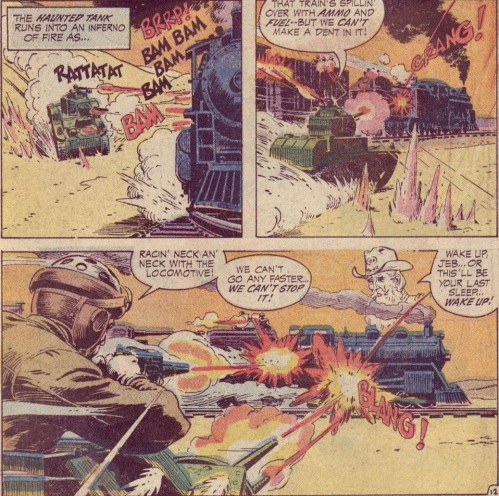
This is a solid story, and I really enjoy the camp episode about Jeb’s name. His quiet, obstinate perseverance is great. The whole thing looks good, as do most of these Haunted Tank tales, and the adventure with the train is a neat change of pace. Interestingly, this origin actually contradicts an earlier one from issue #114. Leave it to Kanigher to botch some continuity. That earlier story tells the tale of how General Stuart himself came to be attached the the tank, and it is an interesting one. I rather wish that supernatural side of the concept had been explored a bit more, but I imagine they had to walk lightly about such things in the Silver Age. Perhaps we’ll see more done with it in future issues. At any rate, I’ll give this fun and interesting issue 4 Minutemen, though it loses a bit for the continuity kerfuffle.

Justice League of America #84
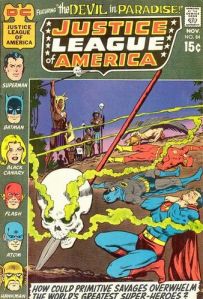 “The Devil In Paradise!”
“The Devil In Paradise!”
Writer: Robert Kanigher
Penciler: Dick Dillin
Inker: Joe Giella
Letterer: John Costanza
Editor: Julius Schwartz
“Great Ant Circus!” (reprint)
Writer: Gardner Fox
Penciler: Murphy Anderson
Inker: Murphy Anderson
Letterer: Gaspar Saladino
Editors: Whitney Ellsworth and Julius Schwartz
This is an odd one. Denny O’Neil’s groundbreaking run on the book is over, and we get one issue with a fill-in writer before the beginning of Mike Friedrich’s run. It seems like Kanigher (yes, he strikes again) was going for a ‘Very Special Episode’ type of story with this comic, but the result is so uneven and random, with the melodrama turned up to 11, that the resulting read doesn’t ever really come together. Unlike the last few mostly tolerable Kanigher offerings, this one is full of poorly thought-out events, abandoned plot points, and overall sloppy writing. It isn’t the worst story of his we’ve covered, and it actually still manages to be somewhat enjoyable. Nonetheless, it is weird.
Almost immediately after it begins, we get a flashback. The JLA are receiving a special Nobel Prize, which is actually a cool idea and something that makes perfect sense for a group of people who regularly save the entire world. This particular instance is actually rather small-potatoes, as the team receives the reward for saving a kidnapped scientist before he could be “sold behind the Iron Curtain.” In a fun touch of continuity, the organization they’re tangling with is The 100, the same group that has begun to make its presence known in some of the Superman books also penned by Kanigher.
The 100 have a veritable army guarding the scientist, and we get a fun sequence where all the gathered members of the League get to chip in during the rescue, though the creators apply cartoon logic to Superman’s powers, as he melts an entire tank, somehow without deep-frying the guys inside. They’re literally sitting in molten steel and only seem mildly perturbed in a ‘How dare you melt my tank’ kind of way. You can’t see him, but I have a sneaking suspicion that Yosemite Sam was actually piloting that tank.

Yep, it sure is a good thing that the melting temperature of flesh is so much higher than steel!
While the others keep the gang busy, Hawkman affects the professor’s rescue with an assist from the Flash, and that brings us back to the ceremony. After the League’s time in the limelight, another recipient takes the stage, Dr. Viktor Willard, whose ‘Pax Serum’ has turned “the hawks of savage, primitive tribes of the Matto Grosso country into doves!” Now, if that sentence didn’t disturb you, A) you haven’t read enough science fiction or B) you didn’t think about it enough. This guy invented some kind of drug that made human beings docile. That’s a dystopian dictatorship’s dream! What’s more, he presumably gave it to an unwilling population, forcibly restraining their hostile tendencies. That’s wildly ethically problematic! Yet, the League and the Nobel crowd seem to think it’s the greatest thing in the world. Yay! Let’s just drug people to make them act the way we want! Shades of Equilibrium!
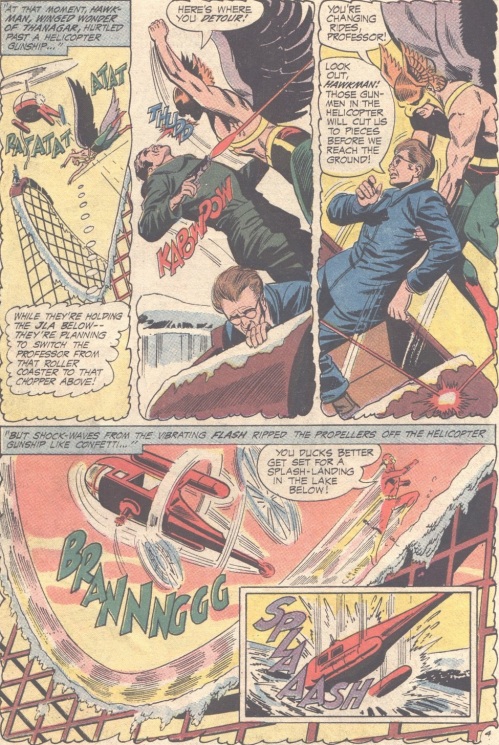
Anyway, that’s not even the weirdest thing to come out of this scene. All of a sudden, with no explanation, Black Canary becomes telepathic, reading the thoughts of Willard’s fiance, Phyllis Temple. Oddly, she calls her new ability “SP.” ESP stands for extra-sensory perception, but I’m guessing ‘ol Kanigher just got confused. To add to the inexplicable oddities, Superman’s x-ray vision suddenly goes haywire, and he sees half of Willard’s face as a skull. That is never mentioned again, by the way. It’s just a random little bit of madness. On the way home from the event, Superman and Flash have a race, but it proves too destructive, so they call it off.
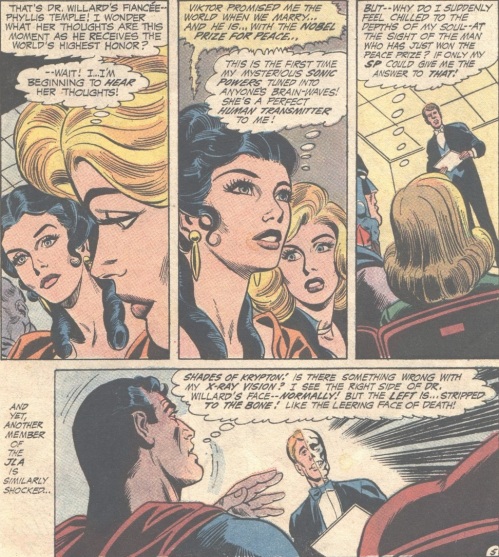
Next, we get an incredibly, achingly melodramatic scene between Batman and Black Canary. They cross paths in the Watchtower, changing shifts for monitor duty, and they share a kiss, instantly regretted by both, as the heroine is still mourning the loss of her husband. It’s not that bad of a scene, but the captions are just too much! I wonder what Ollie would think of this. My wife would hate this scene, as she will hear of no other love interest for Batman but Catwoman. I’m not quite as militant about it, but that pairing does have a place in this old softie’s heart.
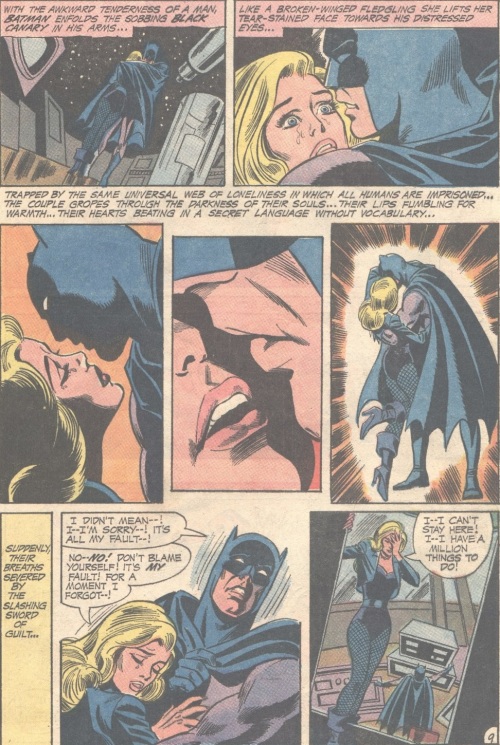
Anyway, the plot, such as it is, picks up two days later as the League responds to a distress call from the remote hinterlands of Australia where a native village has been destroyed by another tribe, which has seemingly gone mad. Suddenly the team is attacked by Aborigines with weird weapons and mirrored shields. The heroes have a brief fight, but then their opponents just vanish and we get some gobbledygook about the natives’ belief in the supernatural and the heroes’ belief in science. What does this have to do with our main plot? Your guess is as good as mine, since it is never explained. Were these folks experimented upon by Dr. Willard? Are they just random natives practicing black magic? Who knows? The League don’t bother to find out, just leaving with the whole matter uninvestigated. Way to go, team!

Cool panel, though.
On the way home, the Flash discovers the recent Laureate’s fiance floating on an overturned boat, delirious. He rushes her to the hospital in Central City (which I suppose is really no further away for him than a coastal hospital). While comforting her, his wife, Iris, arrives, steaming mad and ranting about how he missed her receiving a reward. She declares “The JLA’s no place for a married man! Let your superhero bachelors carry on!” This is another completely random, completely out of character moment. Shades of Bob Haney! Iris has always been very supportive of Barry’s superhero career, so this comes out of nowhere and, I’m fairly certain, goes nowhere as well.
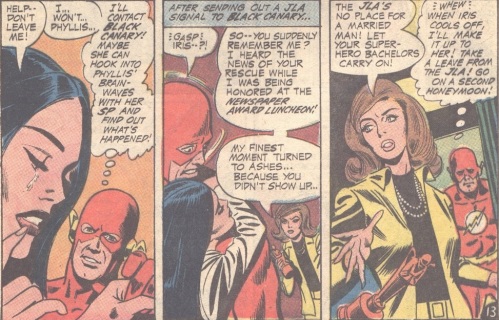
The League brings in the suddenly-telepathic Black Canary, and the bird-lady sings about what she sees in Miss Temple’s mind. Apparently, her fiance went from Nobel Peace Prize recipient to flat-out Bond villain, complete with secret volcano lair, all in the blink of an eye! The mad scientist flew her to his private island base and explained his randomly evil plan to her. He declares that, for no particularly good reason, instead of curing aggression in the world, he’s going to ramp it up to cause a holocaust, leaving the pair of them safe in their underground bunker. He also introduces her to his incredibly vaguely defined servant, “Nether Man,” described as “Neither man, robot, nor android.” Sure. Why not. Nether Man is smitten with the lovely Miss Temple, but when she escapes, he is sent to hunt her down nonetheless, sinking her speedboat in the process.
Having gotten the scoop, the League leaps into action, encountering a series of booby-traps and obstacles on the island, which give several different members a chance to shine. It’s a nice sequence, as Superman detonates mines, the Atom picks a lock, and Hawkman dodges lasers. Then, while they are fighting really uninspiringly designed robots, Flash has a line that irks the literary scholar in me, as he refers to ‘machines turning against men’ as “Orwell’s nightmare world of 1984.” What? 1984 has nothing to do with machines turning against men! Sheesh, Kanigher, read a book!
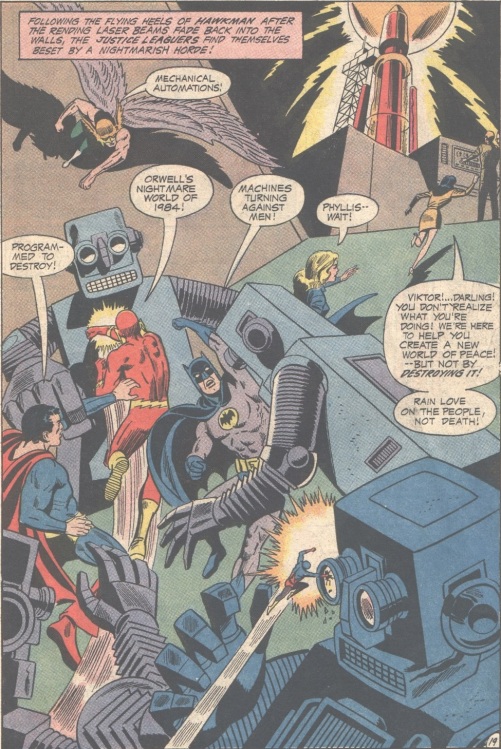
While the League are occupied, Phyllis runs to confront her fiend of a fiance as he is preparing to launch his doomsday device. He orders Nether Man to kill the meddlesome woman, only to have his creation turn on him, destroying itself in the process. The final page of the issue attempts to deliver some kind of moralizing message, but it makes no sense with the story that’s just concluded, as Phyllis philosophizes that both Nether Man and Dr. Willard are “victims of the same hate that ravages the world! Unwitting murderers! But…who can cast the first stone at them?” Wait, what? What story were you reading, lady? Those two were victims of the hate that your psycho boy-friend whipped up trying to annihilate humanity! I’d call him a pretty ‘witting’ murderer, and, while I’m no saint, I feel fairly comfortable in my moral fitness to throw the first stone at attempted genocide.
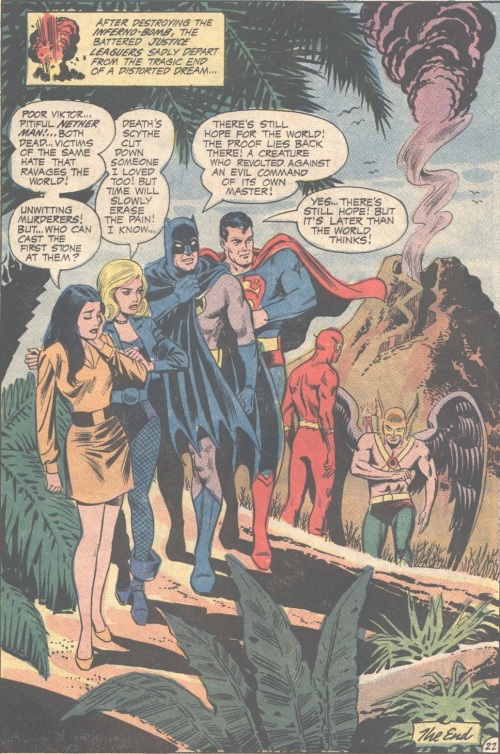
Clearly, we’re meant to find this ending super profound and meaningful, but the story just doesn’t earn anything of the sort. The Frankenstein-esq turn with Nether Man is good, and surprisingly well handled in a very short span of time, but his master gets pretty much zero motivation for his genocidal tendencies. The issue is chock full of material and has plenty of action, but it really feels like three or four separate, disjointed stories rather than one unified plot. The Aristotelian Unities don’t really apply to comic stories, but some type of unity of action is important in any conventional yarn. This issue certainly fails at that, and while there are some fun team moments and even some interesting ideas introduced, like the attraction between Batman and Black Canary, the strange, discordant notes of unexplained events, incongruous dialog and action, and general lack of development and, you guessed it, logical consistency, leave it something of a mess. It’s not a bad read, but if you think about it for more than two seconds, you’ll find your head hurting. I’ll give this off-beat issue 2 Minutemen. It certainly seems like those last few solid Kanigher issues might have been the fluke after all, but just wait until you see what’s next!
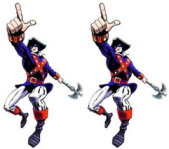
Superman’s Girlfriend, Lois Lane #106
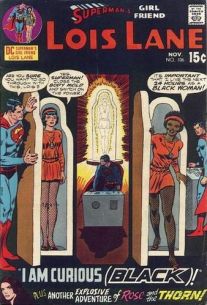 “I Am Curious (Black)!”
“I Am Curious (Black)!”
Writer: Robert Kanigher
Penciler: Werner Roth
Inker: Vince Colletta
Letterer: Milton Snappin
Editor: E. Nelson Bridwell
“Rose and Thorn: ‘Where Do You Plant a Thorn?'”
Writer: Robert Kanigher
Penciler: Ross Andru
Inker: Mike Esposito
Editor: E. Nelson Bridwell
Wow. Just….just wow. This is an amazing comic. I know that is hard to believe. Just look at that title and that cover, not to mention the name in the credits! Nonetheless, this is a heck of a comic book. I expected this issue to be a terrible, ham-handed, melodramatic mess. How could it be anything but, right? Well, I was blown away by what was under that goofy cover. Robert Kanigher, of all people, managed to tell a simple, subtle, touching, and authentic story about race, bigotry, and inequality that gently delivers a a message of human unity without beating the reader over the head with it. This comic actually achieves the profundity that Denny O’Neil is trying so desperately to grasp in each new issue of Green Lantern/Green Arrow.
This unusual story starts off with Lois Lane, clearly entirely pleased with herself, as Lois often is, having just received an assignment to get “the inside story of Metropolis’ Little Africa,” an all Black neighborhood in the poorest part of the city. In a somewhat creepy little panel, Clark thinks, for no particular reason, that he’s going to ‘keep an eye on her’ as Superman. I’m sure that won’t be significant later. The glamorous girl reporter gets a ride from her favorite taxi driver and heads to the slums. Yet, when she arrives, she gets the cold shoulder from all of the area’s inhabitants. They just refuse to talk to her, politely ignoring all of her efforts to break through.
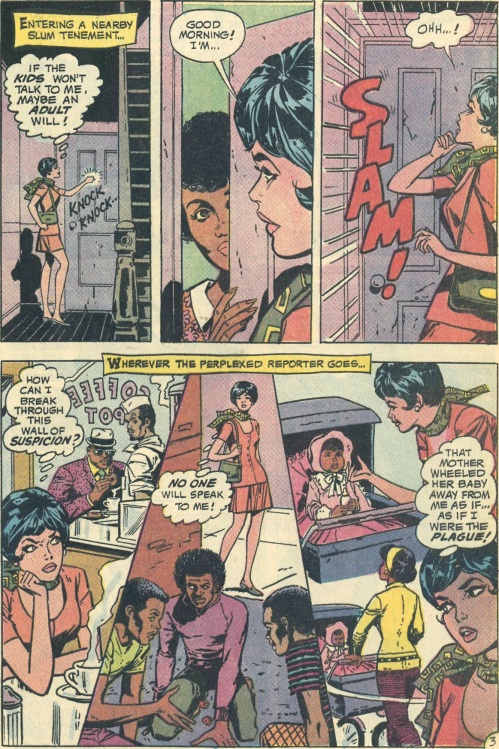
There’s a particularly striking scene where she passes a street meeting and a fiery young man points her out, noting that, though she is young and pretty, they must not forget that:
“she’s whitey! She’ll let us shine her shoes and sweep her floors! And baby-sit for her kids! But she doesn’t want to let our kids into her lily-white schools! It’s okay with her if we leave these rat-infested slums! If we don’t move next to her! That’s why she’s our enemy!”
It’s a really surprisingly honest moment, dealing fairly straight-forwardly with issues of school desegregation and white flight. The young man’s earnest anger is shocking, as is the subject matter appearing in a superhero comic, much more in Lois Lane. Kanigher shows admirable restraint in moments like this throughout the book, letting the scenes speak for themselves, and they speak eloquently. Lois herself is struck by this speech. She ponders how, though the young man’s words aren’t true for her, they are true for many of her race.
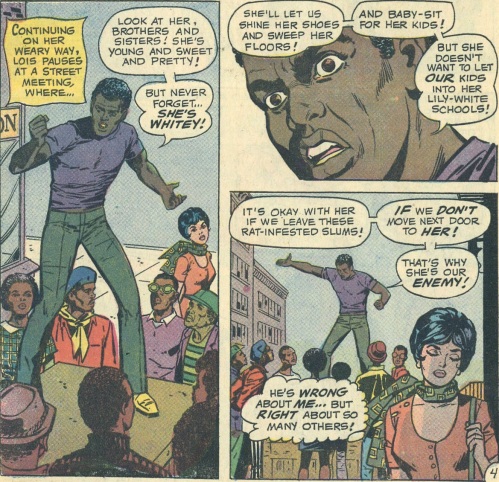
Having determined that she won’t get any story out of this neighborhood while she’s looked at as an outsider, Lois conceives of a bold plan. She convinces Superman to use a kryptonian device to temporarily turn her into a Black woman so she can see what the world looks like through such people’s eyes. What follows is a short but telling collections of scenes where Lois, suddenly not the “right” color any longer, discovers how different life is for the other half. Her favorite taxi driver blows right past her on a rainy street, refusing to pick her up. On the bus, she’s the subject of suspicious looks, or at least feels that way. That’s one of the most remarkable things about this story. Kanigher captures, not only the obvious signs of racial inequality, but the general sense of ‘otherness’ that minorities have to deal with. That’s impressive.

Arriving in the slums, Lois heads in to one of the tenement buildings to talk to some of the inhabitants, only to find a fire starting in a trash pile. The place is incredibly run-down, and one of the renters informs the disguised reporter that the slumlord who owns the place refuses to do any maintenance. That renter invites Lois into her home and what follows is something akin to the Widow’sMite. This woman, who has almost nothing, who has to chase rats out of her baby’s room, offers Lois coffee, shares her hospitality, and then asks this complete stranger if she needs any help. It’s a touching little scene, and it helps to ground the humanity of the folks trapped in this area.
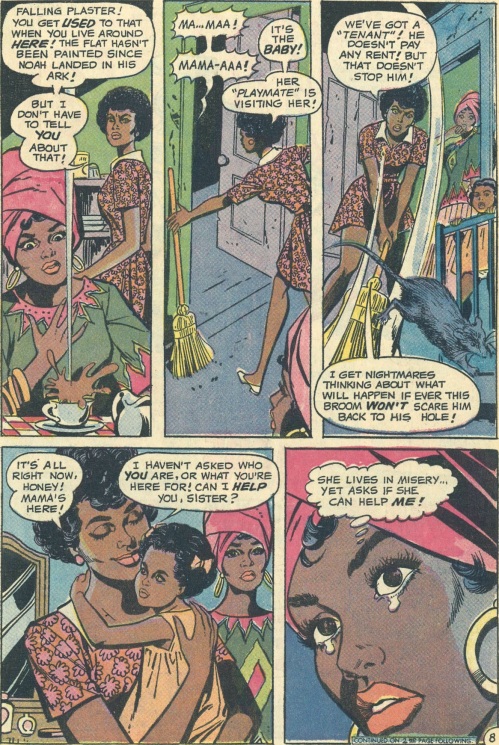
Lois is moved, and she heads out to see what else there is to see. In an alley, she spots an ‘improvised pre-kindergarten,’ where a man is teaching a group of children that ‘Black is beautiful.” This may strike you as odd, especially if you aren’t familiar with American racial history, but it is actually a really interesting and subtle addition to the story. You see, the famous Doll Test in the 40s indicated that segregation and racial inequality had a psychological effect on minority children. They literally preferred white skin to theirs, tending to have subconsciously absorbed the narrative or racial inferiority. It’s a pretty heartbreaking idea that kids might be uncomfortable and unhappy in the skin they’re born in, but that was (and may still be) the world that we had created. Once again, Kanigher displays surprising sensitivity and insight.
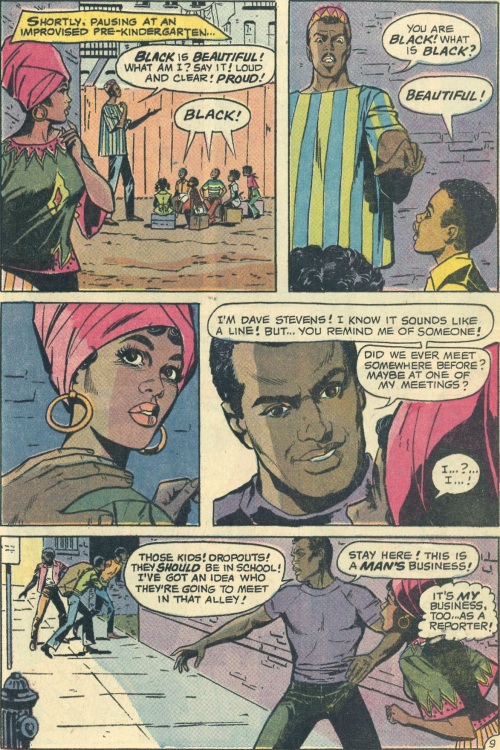
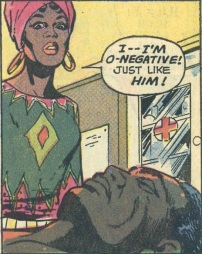 Well, the crisis of the story arrives when Lois meets the fiery street speaker she had encountered earlier, but the young man, named Dave Stevens, of course, doesn’t recognize her. He does recognize a gang of kids creeping into an alley to meet a pusher, however, and charges after them in order to protect his neighborhood. The thugs meeting the kids don’t take kindly to the interruption and shoot the brave fellow. Superman arrives just then and captures the criminals, then rushing the wounded man to the hospital. It’s at this point that we get one of my favorite panels in the book. Stevens needs o-negative blood for a transfusion, but the hospital is out. Lois, with a wonderfully rendered expression of realization, simply states “I–I’m o-negative! Just like him!” There’s no heavy-handed captions, no undue focus. The moment stands on its own, and it is a great moment. Lois realizes that she, a White woman, shares the same blood that is coursing through the veins of this Black man. That she is the same, inside, as he is. It’s really lovely.
Well, the crisis of the story arrives when Lois meets the fiery street speaker she had encountered earlier, but the young man, named Dave Stevens, of course, doesn’t recognize her. He does recognize a gang of kids creeping into an alley to meet a pusher, however, and charges after them in order to protect his neighborhood. The thugs meeting the kids don’t take kindly to the interruption and shoot the brave fellow. Superman arrives just then and captures the criminals, then rushing the wounded man to the hospital. It’s at this point that we get one of my favorite panels in the book. Stevens needs o-negative blood for a transfusion, but the hospital is out. Lois, with a wonderfully rendered expression of realization, simply states “I–I’m o-negative! Just like him!” There’s no heavy-handed captions, no undue focus. The moment stands on its own, and it is a great moment. Lois realizes that she, a White woman, shares the same blood that is coursing through the veins of this Black man. That she is the same, inside, as he is. It’s really lovely.
The transfusion is conducted, and it is a success! While the young man recovers, Lois has an interesting conversation with the Man of Steel, asking him, point blank, if he would marry her if she was couldn’t change back. His response is really fascinating, as he doesn’t ever really answer her. He points out that he is the ultimate outsider, being an alien, but she retorts that his skin is “the right color.” It’s intriguing to see other writers toying with the idea of Superman as a representative of the established order, a symbol of conservatism and resistance to change. The man himself seems better than that, but there is a touch of that old fear, that superheroes are inherently fascistic or oppressive, defending the existing social order as they do. I’ve always found that argument foolish, as heroes can and do inspire folks to be compassionate and courageous, but the possibility is certainly there. Just last month we saw Jack Kirby putting Superman in a similar role by placing him at odds with Jimmy, as a representation of youth culture. We’re certainly getting into pretty interesting stuff on this front, no doubt about it.
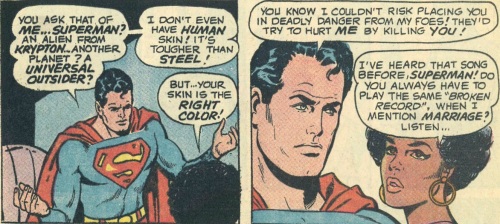
The issue ends with Lois, having transformed back into her usual coloring, greeting the revived young man. Once again, Kanigher makes an excellent choice of restraint. The final pages is wordless, with nothing but the dawning realization and acceptance on Dave Stevens’ face to tell the story. He recognizes the same truth that the reporter herself did, that inside, they are the same, whatever outward differences may appear. It’s a good, hopeful ending. It’s touching without being saccharine, and I really don’t think it could have stood any dialog or captions and still kept that balance.
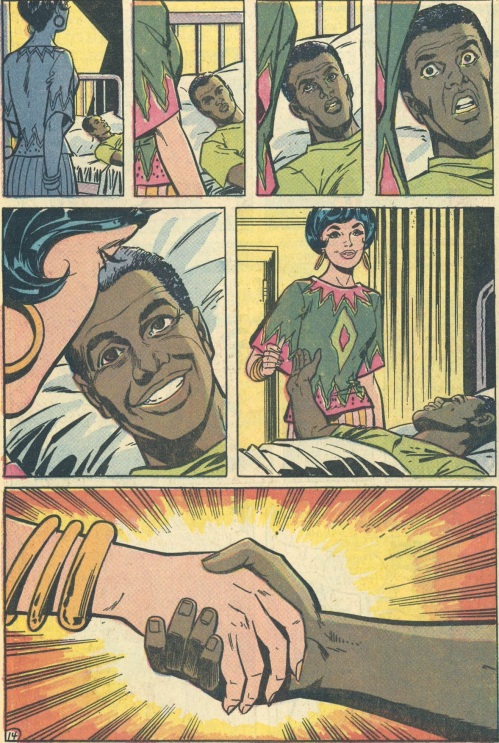
I think what may be most astonishing to me about this book is the fact that I’ve never heard of it. I’ve read a decent amount about comics and their seminal moments. I’ve read about Denny O’Neil’s Green Lantern run, the drug abuse issue, and more. I’ve heard about a lot of the important stories, and yet…this issue has never had a mention so far as I can tell. It has never garnered any notice, but it is a bold and sensitive (for a 14 page comic story) treatment of some very timely issues. I can only imagine that no-one was paying any attention to Lois Lane. I know I certainly didn’t expect to find an honestly poignant story in these pages! Yet here it is, a forgotten gem. This type of book is one of the reasons I started this project. I am thrilled to have discovered it, not least because its message of seeing through the other fellow’s eyes is especially fitting these days, at least in my country. That’s one of the great strengths of literature. It builds our capacity for empathy and helps us to look at the world from different perspectives. That’s one of the ways that literature makes us better as human beings, and this little story in an insignificant comic magazine has just such power.
The whole issue is beautifully illustrated by Werner Roth, who I’ve never heard of before. I’ll be looking for his name from now on, though! He really captures the emotions of the various characters and gives each extra an interesting and unique face. Lois herself is given a lot of personality by both Kanigher and Roth, and I think her portrayal is one of my favorite parts of the issue. She is represented as intelligent, capable, and level-headed, which is great given how often the Silver Age Lois was just a complete mess, a mad, manipulative, emotionally disturbed harpy. This story gives us a more worthwhile Lois, and I quite enjoyed it. Overall, I can’t think of any way this comic could be improved, so, this 14 page Lois Lane story written by Bob Kanigher of all people is the first Bronze Age book to earn 5 Minutemen out of 5! Clearly, I’m going to have to reassess Kanigher as a writer.
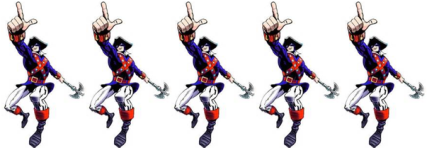
“Rose and Thorn: ‘Where Do You Plant a Thorn?'”
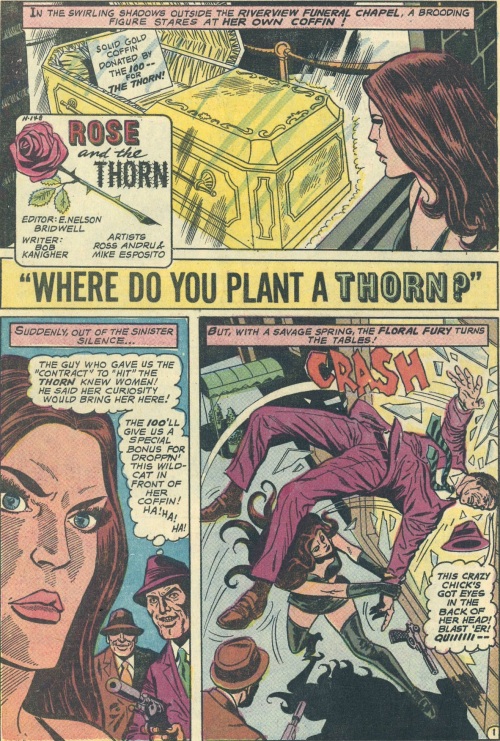
Apparently Thorn is actually a man in drag…yeesh!
This is another interesting and engaging Rose and Thorn story, probably stronger than the first offering because it doesn’t have as big of a job to do since the origin has already been told. It can focus on smaller tale and give it more development. The concept continues to intrigue me, and I’m pleasantly surprised once again by Kanigher’s writing in this backup.
This particular yarn opens with the eponymous Thorn gazing at the window of a funeral home at a solid gold coffin on display there. Apparently the 100 like grand gestures, as they’ve commissioned this flashy final resting place just for her. As she considers the coffin, a pair of the 100’s gunmen come after her, but she makes short and vicious work of them. In fact, it may only be the arrival of her father’s former partner, Danny Stone, that saves the life of one of the thugs. That’s a little touch that I enjoy, as Thorn isn’t exactly a rational and restrained heroine. It makes sense that a vengeance driven split personality might have some problems with excessive violence. I’m curious to see if that will be developed.

Anyway, the story continues the following day, when Rose is once again in control, and she is palling around town with her new boss, Vince Adams, owner of the funeral home and secretly a leader of the 100. We get some good intrigue as Rose is left to browse the flowers in a florist shop owned by another 100 member as he and Adams meet to discuss the murder of her alter ego. The florist is charged with killing Detective Stone, and when the officer just happens to waltz into his store seeking roses for Rose, he sees his chance. One poisoned bouquet later, and the trap is set. Fortunately for Rose and Danny, the girl’s dog chews on one of the flowers, dying in their stead! I was really surprised by this. Usually you never kill a pet in a comic like this, even if you kill human beings. It is pretty dark, as an animal is completely innocent, and it’s the kind of thing that forever marks a villain. Folks can forgive a likeable rogue for a little murder, but never animal cruelty. Such are the vagaries of audience ethics!
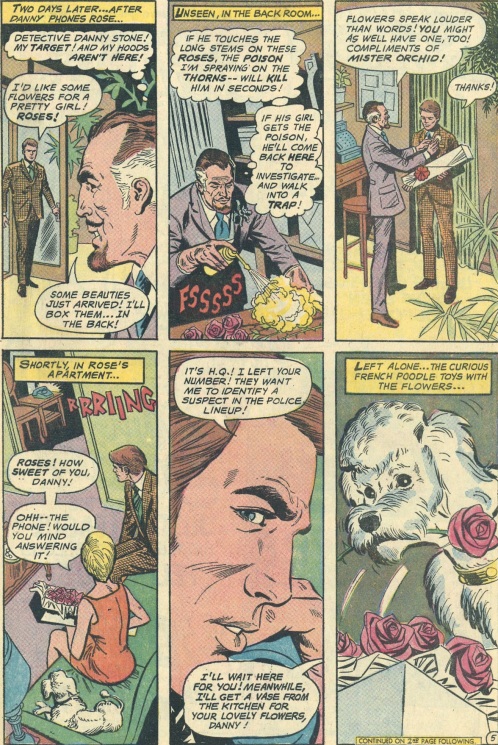
Well, Stone realizes that something is up, and instead of descending on that florist shop with a SWAT team, he just strolls in casually to ask the guy how his flowers ended up poisoned. What’s more, he also blindly accepts the ridiculous story the guy tells him about having bought the flowers from some strange trucker and walks right into the trap the store owner sets up. Detective Stone is apparently exceptionally bad at his job. It’s a good thing he’s working in Metropolis. Without Superman around, he’d probably already be dead.
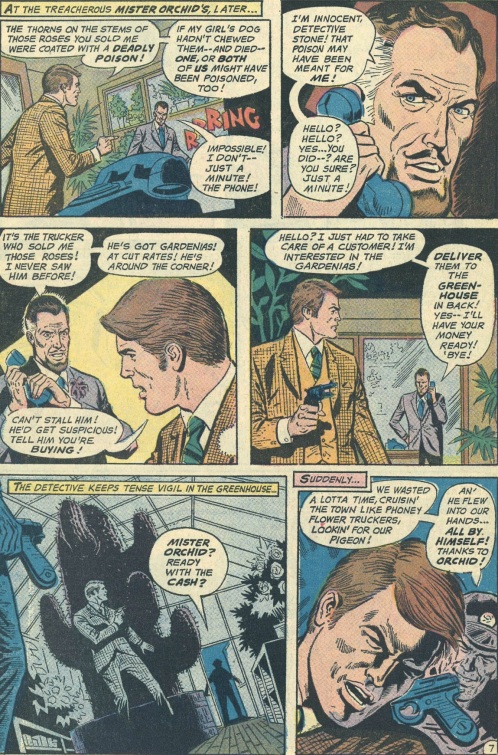
What is going on in that last panel? Is the gun animate?
He gets lucky once more, however, as once he is sapped, Thorn comes to his rescue, making a dynamic entrance and leaving the two gunsels stuck to a giant cactus! They look like they’ve been crucified, so it is a rather striking image. Stone recovers and captures the two thugs, probably getting credit for a collar he doesn’t deserve.
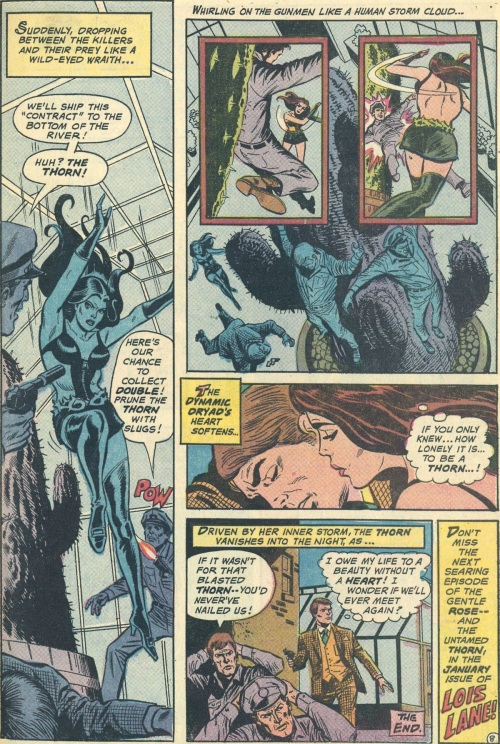
This is a solid little tale, told in just 8 pages. It’s a good example of economical storytelling, and Kanigher fits in action and character development admirably. The small cast helps that task, of course. Ross Andru’s art is actually one of the biggest weaknesses of this story. While it is usually serviceable, even rather good with some of the face-work, it is also occasionally stiff, awkward, and just downright ugly in some spots, especially the opening page with Thorn. There’s a few places where the art fails the story as well. Still, all-told, this is a good story in a remarkable issue. Color me intrigued by Ross/Thorn’s saga. I’ll give this one 4 Minutemen, though I’m inclined to take off some points for Stone’s ridiculous gullibility.

Well, what a fascinating selection of issues we’ve covered in this post! I just can’t figure Robert Kanigher out. He can turn out the goofiest, laziest, scholckiest work you’ve ever seen in one book and yet turn out one of the best short comics I’ve ever read in another, all in the same month! Whatever Kanigher’s story may be, we’re certainly getting into intriguing trends here at the end of 1970, and we have only one more post to go before we round out November. So, until next time, keep the heroic ideal alive!


re JLA: I’m thinking SP stands for Sonic Powers boldfaced in the previous panel.
Still, it’s as goofy a contrivance as Superman’s Fruit-Roll Up-esque detachable symbol from Superman II.
Haha! Thanks for pointing that out, Scott! I had wondered if that was the intended usage, but since ‘Sonic Powers’ in no way accurately describes telepathy, I thought that it couldn’t be. However, given the level of thought put into the issue, it’s likely you’re right!
“I Am Curious (Black)” was a riff on the title of the controversial Swedish film “I Am Curious (Yellow)” released in the US the year before, although they had nothing in common plot-wise.
For those of a certain age, Werner Roth was best known for his run on Marvel’s X-Men comic during the mid-to-late 1960s…his style never really suited superhero titles, but was ideal for the Lois Lane strip and others that had a more “normal” (ie non superhero flash) style.
Fascinating! Thanks for sharing that, B Smith. I read a bit about that film, and it sounds completely bonkers! There’s definitely a difference, but the name has got to be a reference. Odd.
A friend of mine actually just mentioned Roth’s work on the X-Men to me, which I never noticed though I’ve probably read all of those issues. I can definitely see how he would be better suited to more mundane stories, as his work with Superman’s few moments of action are the weakest in the book, while the everyday scenes are the strongest.
Thanks for the comment!